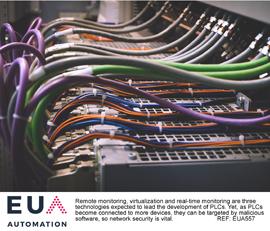By Jonathan Wilkins, marketing director, EU Automation
An etymological fallacy is an assumption that a word’s current and historical meanings are the same. However, as language evolves, modern definitions do not necessarily resemble original ones. To take an example,‘lord’ is a compound of Old English ‘half’ and ‘weard’, meaning bread and keeper respectively. This does not make it correctto use lord to refer to someone who bakes or keeps bread, regardless of its roots. It is more sensible, therefore, to argue the definition of a word is instead the most option.
Here Jonathan Wilkins, marketing director at obsolete industrial parts supplier,EU Automation, discusses the evolution of the programmable logic controller (PLC), and predicts what the future might hold for this crucial piece of equipment.
 A PLC is an automated decision-making tool that is commonly used in manufacturing sectors, such as chemical processing, pharmaceutical, automotive and aerospace.
A PLC is an automated decision-making tool that is commonly used in manufacturing sectors, such as chemical processing, pharmaceutical, automotive and aerospace.
Since the creation of the PLC in 1969, factories have become better connected as different components link to one another and to the internet.
Technological advances and the introduction of the Internet of Things (IoT)mean each device has many inputs, usually in the form of sensor readings. Information relating to motor torque, electrical interference and magnetic force is constantly being fed back, so the PLC needs to be network enabled in order to process the information.Often, PLCs have a huge quantity of data to process, therefore require a higher bandwidth.
As PLCs become connected to more devices, they can be targeted by malicious software – as infamously demonstrated by the Stuxnet worm – IoT presents a risk of its own, so network security is vital.
The security of a PLC is not built by design – any compatible code can run on a PLC, regardless of where it comes from, so the potential for infection from malicious code is large.
Manufacturing trends
Globalization leads to multiple plants in simultaneous use, and so the need for data to be gathered and analyzed grows. Supervisory Control and Data Acquisition (SCADA) systems are an existing solution that allows real time data gathering from PLCs in multiple plants. However, there is not currently an existing technology that can be embedded into the PLCs themselves to allow for remote control. The next generation of PLCs has the potential to build on this to enable remote operations.
Future focus
Remote monitoring, virtualization and real-time monitoring are three technologies expected to lead the development of PLCs. There is potential to create a PLC that assists companies in the adoption of Industry 4.0, but manufactures and operators need to recognize and fight potential security issues and connectivity setbacks.
It might well be that the future PLC doesn’t resemble what we know it to be today. The question is, are these devices still PLCs or a new technology entirely? An automated fallacy, if you will. One thing that we are certain of is that a device which functions as a PLC will forever be essential.






